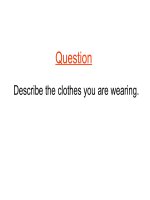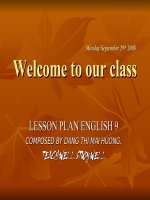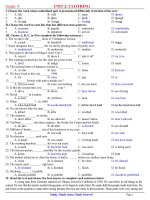- Trang chủ >>
- Đề thi >>
- Đề thi lớp 6
Unit 2 Clothing
Bạn đang xem bản rút gọn của tài liệu. Xem và tải ngay bản đầy đủ của tài liệu tại đây (150.38 KB, 24 trang )
<span class='text_page_counter'>(1)</span>WEEK: 3 Date of preparation: Period : 7 Date of teaching : : UNIT: 2 CLOTHING. LESSON: 1 GETTING STARTED & LISTEN AND READ. I-Aims and ojectives: - Language content: - To introduce some new words relating to the Ao Dai in Viet Nam. - To review the present perfect tense and the passive. - Language function: - Talking about the traditional dress of Vietnamese women. -Educational aims: - To educate the Ss to keep and respect the traditional beauty of each nation. 1-Language: a- Vocabulary: poet, a long silk tunic, slit, inspiration, ethnic minorities, pattern. b- Structures: The present perfect tense and passive voice. 2- Skills: Integrated skills. 3- Educational factor: To educate in the Ss the pride of their traditional Ao Dai. II- Teacher and Students’ preparation: 1- Method: Communicative approach. 2- Techniques: Repetition, explanation, using pictures, gap filling, game. 3- Materials needed: Textbook, pictures, cassette player. 4- Students’ preparation: Pictures, new lesson. 5- Previous exercises: The teacher’s key to the last exercises. III- Procedure in class: 1- Stabilization (3ms). a- Warm up: Greeting b- Checking absence: Who’s absent today? 2- Checking up the previous knowledge (5ms) * Questions: Asks the Ss to go to the board and do exercise: “ Write sentences beginning I wish…. 1- I’m sorry I can’t go to the party. 2- I don’t know people in the town. * Keys to the questions: According to each Ss’ ideas. 1- I wish I could go to the party. 2- I wish I knew many people in the town. 3- Presentation of the new materials: Time 5ms. Teacher’s activities 1- Lead- in. * Getting started: - Uses the pictures in the book and asks the Ss: + Where does the woman/ man come from?. Students’ activities. -Answer the Teacher’ questions: + She/He comes from Japan/ Viet nam/ Scotland/ India/ USA/Arabia. + Look at their clothes.. The content of the lesson . UNIT: 2 CLOTHING. Lesson: 1 GETTING STARTED &.
<span class='text_page_counter'>(2)</span> Time. Teacher’s activities +Why do you know where they are from….(Japan) ? - As you know, each nation has their traditional clothes and so do Vietnamese people: How does the Ao Dai originate? And how has it been changed? - Introduces the new lesson: “ you are going to read a text about the traditional dress of Viet nam”. 10ms. II- Pre- reading. - Plays the tape one time. - Introduces some new words and phrases: + poet (n) (example) + a long silk tunic (translation) + slit (v) ( explanation: to make a long thin cut in something. + inspiration(n) (translation) + ethnic minorities ( example: Thai, Muong…) + pattern (n) ( picture) + unique (adj) (explanation) + desinger (n) (example: Hong Hanh is the most famous Ao Dai desinger in VN.) - Asks the Ss to read the new words. - Checks understanding of the new words by using the technique: Rub out and remember. - Reviews:+ the present perfect tense: S + have/ has + V p.p. + the passive voice: S + to be + V p.p + by. Students’ activities. The content of the lesson LISTEN AND READ. - Listen to her. -Listen to the tape. - Focus on the Teacher’s explanation and write down.. * New words and phrases: + poet (n). + a long silk tunic. + slit (n). + inspiration (n) + ethnic minorities. + pattern (n) + unique (adj). + desinger (n).. - Read the new words. - Play the game with the Teacher’s guiding. - Listen and write down.. * Grammar: + the present perfect tense: S + have/ has + V p.p + the passive voice: S + to be + Vp.p + by...
<span class='text_page_counter'>(3)</span> Time. Teacher’s activities. 12ms. III- While- reading. - Asks the Ss to listen to the tape. - Has the Ss read in silence. - Gets the Ss use the information in the passage to do exercises a) on page 14( individual). - Asks the Ss to share with their partners - Calls on some Ss to read the answers. - Gives feedback and corrects. - Asks the Ss to read the text again and work in pairs to answer the questions in exercise b) on page 14. - Calls on some pairs to practice in front of the class. - Gives feedback and corrects.. Students’ activities -Listen to the tape. - Read in silence. - Use the information in the passage to do exercises. - Share with their partners. - Read the answers. - Listen and take notes. - Read the text again and work in pairs to answer the questions in exercise b) on page 14. - Practice in front of the class. - Listen and take notes.. The content of the lesson * Exercises: + Exercise a) 1-……poems, novels, and songs. 2- ……long silk tunic with slits up the sides worn over loose pants. 3- …….to wear modern clothing at work. 4- …..printing lines of poetry on it. 5- …..symbols such as suns, stars, crosses and stripes. + Exercise b) 1-Traditionally, men and women used to wear the ao dai. 2- Because it is more convenient.. 5ms. IV- Post- reading. - Tells: After you have read and understood what the passage talks about, now answer my questions: 1- Do you like to wear the Ao Dai?. 2- How do you feel?. 4ms. V- Consolidation: - Asks the Ss to rearrange all the letters into a right word “ relating to the category of ao dai”. * AO DAI: 1- oermnd. 2- naaloiidttr. 3- mrhca. 4- naaelboihsf. 5- niuueq. * Answer: 1- modern 2- traditional. 3- charm. 4- fashionable.. - Listen and answer the Teacher’s questions:. 1-Yes, I do. 2- I feel beautiful and wonderful…… - Rearrange all the letters into the right a word “ relating to the category of ao dai”.. 3- They have printed lines of poetry on it or have added symbols such as sun, stars, croosses, and stripes to the ao dai..
<span class='text_page_counter'>(4)</span> Time. Teacher’s activities. Students’ activities. The content of the lesson. 5- unique.. 1m. VI- Homwork: - Asks the Ss to: + Learn the new words well and read again the text. + Prepare the new lesson: speak.. - Listen and write down. * Self- evaluation:. WEEK: 4 Date of preparation: Period: 8 Date of teaching: UN IT :2 CLOTHING. LESSON: 2 SPEAK. I Aims and ojectives: - Language content: - To help the Ss to yse the words relating to clothing freely. - To review the present simple, past simple and reported speech. - Language function: - To enable the Ss to ask and answer about their favorite.
<span class='text_page_counter'>(5)</span> - Education aim:. type of clothing. -To educate in the Ss the life’s style of own one in everyday life.. 1-Language: a- Vocabulary: plain, plaid, sleeveless, striped, baggy, fade. b- Structures: The present simple, past simple, reported speech. 2- Skills: Integrated skills. 3- Educational factor: To help the Ss to choose the suitable clothes for each occasion. II- Teacher and Students’ preparation: 1- Method: Communicative approach. 2- Techniques: Explanation, pairwork, groupwork, game. 3- Materials needed: Textbook, pictures, cassette player. 4- Students’ preparation: Pictures, new lesson. 5- Previous exercises: The Teacher’s key to the last exercises. III- Procedure in class: 1- Stabilization (3ms). a-- Warm up: Greeting. b- Checking absence: Who’s absent today? 2- Checking up the previous knowledge (5ms) * Questions: Asks the Ss to read the text, answer the questions and write some new words: 1- Who used to wear the ao dai by tradition? 2- What have fashion desingers done to modernize the aodai? * Keys to the questions: According to each Ss’ ideas. 1- Traditionally, men and women used to wear the ao dai. 2- They have printed lines of poetry on it or have added symbols such as sun, stars, crosses, and stripes to the ao dai. 3- Presentation of the new materials: Time. Teacher’s activities I-Lead- in. - Gives a game: “ Words square”. 5ms. Students’ activities - Play the game with the Teacher’s guiding.. * Answers: ___ jeans, striped, plain, : blouse : suit : plaid, short, II- Pre- speaking - Asks the Ss some questions to lead the Ss into the lesson: + What do you usually wear when:. - Answer the Teacher’s questions.. The content of the lesson. UNIT: 2 CLOTHING. Lesson: 2 SPEAK.
<span class='text_page_counter'>(6)</span> Time 10ms. Teacher’s activities . you go to school? . you stay at home? . you play sports? . you go to the party? - Explains some new words: + plain (adj) ( picture) + plaid (adj) (picture) + sleeveless (adj) ( picture). + stripe (n) (picture) + baggy (adj) ( picture) + fade (v) ( explanation). - Asks the Ss to read the new words - Checks understanding of the new words by using the technique: “What and where “ - Reviews the grammatical note: present simple, past simple, and reported speech. III- While- speaking. * Asks the Ss to look at the pictures and match them with the phrases in the exercise a) on page 14.. 13ms. - Has the Ss compare with the partners. - Calls on some Ss to read the answers. - Gives feedback and corrects. * Asks the Ss to work in groups of 8 or 10 students each to read and write two more questions for the last section of the survey about students’ wear ( in the exercise b) on page 15). - Calls on some groups to practice in front of the class. - Gives feedback and corrects.. Students’ activities. -Focus on the Teacher’s explanation and write down.. - Read the new words.. - Play the technique with the Teacher’s guiding. - Listen and take notes.. - Look at the pictures and match them with the phrases in the exercise a) on page 14.. - Compare with the partners. - Read the answers -Listen and take notes. - Work in groups.. - Practice in front of the -* Asks the Ss to interview their friends ( class. - Listen and take notes. in exercise c) on page 16) - Asks them to report the result of their survey in their group. The survey should - Interview their friends.. The content of the lesson.. * New words: + plain (adj) + plaid ( adj) + sleeveless (adj) + stripe (n) + baggy ( adj) + fade (v). * Review the gramatical note: present simple, past simple and reported speech. * Exercises: + Exercise a) a- a colorful T-shirt. b- a sleeveless sweater. c- a striped shirt. d- a plain suit. e- a faded jeans. f- a short sleeved blouse. g- a baggy pants. h- a plaid skirt. i- blue shorts. + Exercise b) * Casual clothes: 1- On the weekend, I usually wear a Tshirt and jeans or shorts. 2- Because they are convenient and comfortable. * Favorite clothes:.
<span class='text_page_counter'>(7)</span> Time. Teacher’s activities begin as follow: Three people said that they liked their uniform. Two people said thatthey usually wore colorful T- shirt on the weekend. Chi said she loved baggy pants. - Asks the representative from each group to present the result of the survey in front of the class. - Gives feedback and corrects.. 5ms. 3ms. 1m. IV- Post- speaking. - Asks the Ss to talk about the suitable clothes for each season: + In the spring: + In the summer: + In the fall: + In the winter: * Ex: What do you wear in the summer? + I usually wear colorful T- shirt and short in the summer. - Asks the Ss to work in groups. - Calls on some groups to practice before the class and corrects. V- Consolidation. - Gives some pictures and asks the Ss to say the name of clothes ( asks the Ss to close your books and notebooks) Ex: What is this? This is a striped shirt.. VI-Homework - Asks the Ss to: + Learn the new words and the grammatical notes well. + Make a list of types of clothing that most of the students in the class like wearing on different special cases. + Prepare the new lesson: Listen. * Self- evaluation:. Students’ activities - Report the result of their survey in their group.. - Present the result of the survey in front of the class. - Listen and take notes. - Talk about the suitable clothes for each season:. - Work in groups. - Practice before the class and take notes. - Say the name of clothes without looking at the books and noteboos.. - Listen and write down.. The content of the lesson. 1- My favorite clothes are ao dai and jeans. Because it’s nice and convenient. * School uniform: 1- Yes, it’s comfortable. 2- It’s white and blue. * Clothes for special occasions: 1-What type of clothing do you usually wear on Tet holiday/ on christmas Day….. - I usually wear ao dai/ long dress.. 2- What would you wear to a party/ - Iwould wear long dress/ shirt and pants...
<span class='text_page_counter'>(8)</span> WEEK: 5 Period: 9. Date of preparation: Date of teaching: CLOTHING. LISTEN.. UNIT: 2 LESSON: 3 I-Aims and ojectives: - Language content: - To review some words relating to clothing. - To help the Ss to review the present progressive tense. -Language function: Describing what people are wearin -Educational aims Educating the Ss how to behave in a situation- A lost person. 1-Language: a-Vocabulary: announcement, entrance, fair, doll. b- Structures:The present progressive tense. 2-Skills: Integrated skills. 3- Educational factor: To educate the Ss to take care of their younger brothers/ sisters carefully in the public..
<span class='text_page_counter'>(9)</span> II- Teacher and students’ preparation: 1- Method: Communicative approach. 2- Techniques: Repetition, explanation, questions and answer, game. 3- Materials needed: Textbook, pictures, cassette player. 4- Students’preparation: Pictures, new lesson. 5- Previous exercises: The Teacher’s key to the last exercises. III- Procedure in class: 1- Stabilization (3ms). a- Warm up: Greeting. b- Checking absence: Who’s absent today? 2- Checking up the previous knowledge (5ms). * Questions: Asks the Ss some questions: 1- What do you do usually wear on the weekend? 2- Why do you wear these clothes? 3- What is your favorite type of clothing? Why? * Keys to the questions: According to each Ss’ideas. 1- I usually wear jean and shirt on the weekend. 2- Because it is comfortable. 3- My favorite clothes are jean and T- shirt. Because it is convenient. 3- Presentation of the new materials: Time. 5ms. 10ms. Teacher’s activities I-Lead-in. * Revision: - Asks the Ss to write the words relating to CLOTHING on the board. The team which write more words in limited time is the winner. * Answer: - Shirt, skirt, jean, baggy pant…… II- Pre- listening. - Introduces the topic: a public announcement. - Asks the Ss to look at the pictures and say these clothes in English by answering the questions: 1- What are these? 2- What is this? 3- What color is this? 4- What color are these? - Introduces some new words: + announcement (n) (translation) + entrance (n) ( synonym of a gate).. Students’activities. - Play the game with the Teacher’s guiding.. The content of the lesson UNIT: 2 CLOTHING. Lesson: 3. LISTEN.. - Listen to her. - Look at the pictures and say these clothes in English by answering the questions. - Focus on the Teacher’s explanation and write down.. * New words:.
<span class='text_page_counter'>(10)</span> + fair (n) ( explanation) + doll (n) ( realia). - Asks the Ss to read the new words. - Checks understanding of the new words by using the techniques: slap the board.. + announcement (n) + entrance (n) + fair (n) + doll (n) - Read the new words. - Play the game with the Teacher’s guiding.. 13ms. III- While- listening. - Sets the sence: “ You will hear an announcement about a lost little girl called Mary”. - Plays the tape two times. - Asks the Ss to answer the questions: 1- How old is she? 2- Where was she last seen?. 3- What’s she like? - Asks the Ss to listen to the tape again and check the letter of the correct picture to show what Mary is wearing. - Asks the Ss to share the answers with the partners. - Calls on some Ss to give the answers. - Gives feedback and corrects * Answers: a) B: She’s wearing blue shorts. b) A: She’s wearing a long- sleeved blouse. c) C: She’s wearing brown shoes.. 5ms. - Listen to her.. - Listen to the tape. - Answer the questions. 1-She is three. 2- She was last seen near the main entrance to the Car Fair. 3- She has short dark hair. - Listen to the tape again and check the letter of the correct picture to show what Mary is wearing. - Share the answers with the partners. - Gives the answers. - Listen and take notes.. IV- Post- listening. - Describe a friend of - Asks the Ss to describe a friend of theirs, answering the theirs, answenring the questions: questions. + How old is she/he? + What is she/he like? + What type of clothing does she/he like wearing? + What is she/ he wearing today?. * Answers: a) B: She’s wearing blue shorts. b) A: She’s wearing a long- sleeved blouse. c) C: She’s wearing brown shoes..
<span class='text_page_counter'>(11)</span> 3ms. 1m. V- consolidation. - Gives a game “ noughts and crosses” and asks the Ss to give statements with the words given. Homework - Asks the Ss to: + Learn the new words well. + Listen again the tape. + prepare the next lesson: Read.. - Plays the game with the Teacher’s guiding. - Listen and write down.. Self- evaluation.. WEEK: 5 Date of preparation: Period: 10 Date of teaching: UNIT: 2 CLOTHING. LESSON: 4 READ. I-Aims and ojectives: - Language content: - To introduce some new words relating to different styles of jeans. - To review structures: past simple, passive voice, present perfect, start/ st - Language function: After the lesson, Ss knownthe historical development jeans. - Educational aims: Helping the Ss realize the advantages of jeans. 1-Language: a- Vocabulary: Embroider, material, cotton, wear out, style, label. b- Structures: Past simple, passive voice, present perfect, start/ stop+Ving 2- Skills: Integrated skills. 3- Educational factor: Knowing to wear jeans on suitable time occations.. of.
<span class='text_page_counter'>(12)</span> II- Teacher and Students’ preparation: 1- Method: Communicative approach. 2- Techniques: Repetition, using pictures, asking and answering the questions.. 3- Materials needed: Textbook, pictures, cassette player. 4- Students’preparation: Pictures, new lesson. 5- Previous exercises: The Teacher’key to the last exercises. III- Procedure in class: 1- Stabilization(3ms) a- Warm up: Greeting. b- Checking absence: Who’s absent today? 2- Checking up the previous kno *Questions:Asks the Ss to answer the questions in the listening exercises and some new words on the board. 1- How old is she? 2- What’s she like? * Keys to the questons: According to each Ss’ideas. 1- She is three. 2- She has short dark hair. 3- Presentation of the new materials: Time. 5ms. 7ms. Teacher’s activities I-Lead- in. - Asks some questions: 1- What do you usually wear for a picnic? 2- What about jean? 3- What do you want to know about jeans? - Leads in the lesson: “ today we learn the develop of jeans and we can answer these above questions. II- Pre- reading. - Plays the tape one time. - Intriduces some new words: + Material (n) ( translation) + Cotton (n) ( realia) + wear out (v) (explanation) + Style (n) ( picture) + Embroider (v) ( realia) + Label (n) ( realia) - Asks the Ss to read the new words. - Checks understanding of the new words by using the technique: What and Where. - Reviews the structures:. Students’ activities - Answer the Teacher’s questions. write. The content of the lesson. UNIT: 2 CLOTHING. Lesson: 4 READ.. - Listen to her.. - Listen to the tape. - Focus on the Teacher’s explanation and write down.. - Read the new words. - Play the game with the Teacher’s guiding.. * New words: + Material (n) + Cotton (n) + Wear out (v) + Style (n) + Embroider (v) + Label (n). * Review the structures: past simple, passive voice,.
<span class='text_page_counter'>(13)</span> Time. Teacher’s activities + past simple, passive voice, present perfect, start/stop+ V- ing. III-While- reading. - Plays the tape the second time.. 15ms. - Asks the Ss the question: What do you want to know about jeans? Make questions: + Who first desinger jeans? + When did jeans become popular? Why? + Where were jeans made? + What were jeans made of ? + What are some famous jeans desingers? - Asks the Ss to read the text to find out the answers to their questions and add more ideas. - Asks the Ss to read the text to fill in the missing dates and words, exercise a), on page 17. - Has the Ss compare the answers with the partners. - Gives feedback and corrects. * Answers: 1- 18th century….. jeans cloth. 2- 1960s…. students…. 3- 1970s…. cheaper…. 4- 1980s…...fashion… 5- 1990s…...sale…. - Has the Ss work in pairs to answer the questions ( exercise b) on page 18 ) - calls on some pairs to practice in front of the class. - Gives feedback and corrects. IV- Post- reading. - Asks the Ss to work in groups to discuss the questions. 1- Do you like wearing jeans? Why?. Students’ activities. - Listen to the tape the second time. - Answer the Teacher’s questions.. - Read the text to find out the answer to the questions and add more ideas. - Read the text to fill in the missing dates and words, exercise a) on page 17. - Compare the answers with the partners. - Take notes and write down.. - Work in pairs to answer the questions exercise b) on page 18. - Practice in front of the class. - Take notes.. - Work in groups to discuss the questions.. The content of the lesson. present perfect tense, start/ stop + V-ing.. * Exercises: + Exercise a) 1- 18th cetury….. jean cloth. 2- 1960s…. students 3- 1970s…..cheaper 4- 1980s…..fashion. 5- 1990s…..sale…. + Exercise b) 1- The word jeans comes from a kind of material that was made in Europe. 2- The 60s’fashions were embroidered jeans, painted jeans and so on. 3- Because jeans became cheaper. 4- Jeans at last became high fashion clothing in the 1980s. 5- The sale of jeans stopped growing because the worldwide economic situation got worse in the 1990..
<span class='text_page_counter'>(14)</span> Time 6ms. 3ms. 1m. Teacher’s activities Why not? 2- What type of jeans do you love wearing? 3- Do you think jeans are in fashion? - Calls on some groups to practice in front of the class. - Corrects the mistakes V- Consolidation - Asks the Ss to give ideas about : + like jeans:… + don’t like jeans:… * possible answers: + like jeans: fashionable, economical, … + don’t like jeans: hot, thick….. Students’ activities. The content of the lesson.. - Practice in front of the class. - Take notes. - Gives ideas about: like jeans or don’t like jeans.. VI-Homework: - Listen to her and write - Asks the Ss to: + Learn the new words well and read the down. text again. + Write down what they have talked about in groups in their notebooks. + Prepare the new lesson:write.. WEEK: 5 Date of preparation: Period: 11 Date of teaching: UNIT: 2 CLOTHING. LESSON: 5 WRITE. I- Aims and ojectives: - Language content: - To help the Ss know how to give their opinions relating to wearing uniforms at school. - To review the simple present tense. - Language function: Presenting one side of an argumemt. - Educational aims: The Ss should obey the regulations of the school. 1- Language: a- Vocabulary:encourage, be equal in, bear one’s name, freedom of choice, self- confident. b- Structures: - Present simple tense, form of an outline. 2- Skills: Integrated skills 3- Educational factor: The Ss must wear uniforms at school. II- Teacher and students’preparation:.
<span class='text_page_counter'>(15)</span> 1- Method: Communicative approach. 2-Techniques: explanation, translation, asking and answering. 3- Materials needed: Textbook, pictures, cassette player. 4- Students’preparation: Pictures, new lesson. 5- Previous exercises: The Teacher’s keys to the last exercises. III- Procedure in class: 1- Stabilization(3ms). a- Warm up: Greeting. b- Checking absence: Who’s absent today? 2- Checking up the previous knowledge(5ms) * Questions: Asks the Ss to read the text, answer the questions and write some new words on the board. 1- Where does the word jeans come from? 2- Why did more and more people begin wearing jeans in the 1970s? * Keys to the questions: According to the Ss’ideas. 1- The word jeans comes from a kind of material that was made in Europe. 2- Because jeans became cheaper. 3- Presentation of the new materials. The content of thr Time Teacher’s activities. Students’ activities. lesson. I-Lead- in. - Answer the Teacher’s 5ms - Makes some questions: UNIT: 2 a- What’s the weather like today?( fine/ questions. CLOTHING. hot/ sunny). Lesson: 5 b- What are you wearing? WRITE. c- Do you like wearing uniforms? Why or why not? * Possible answers: + Casual clothes: comfortable, selfconfident, colourful and lively, suitable with your favorite choice. + Uniforms: equal, practical, be proud of school. - Gives opinions: Some of you like uniforms, but some others don’t like them. I think, you should wear uniforms at school, so I try my best to get your agreement. Today, I help you to write one side of it. II- Pre- writing. * New words: - Focus on the Teacher’s - Explains some new words: explanation and write + encourage (v) + encourage (v) down. ( explanation). + be equal in (v) + be equal in (v) + bear one’s name (v) 7ms ( explanation) + freedom of choice..
<span class='text_page_counter'>(16)</span> Time. Teacher’s activities. + bear one’s name (v) ( picture). + freedom of choice . ( translation). + self- confident ( adj) ( translation) - Asks the Ss to read the new words. - Checks understanding of the new words by using the technique: Rub out and Remember. - Asks the Ss to look at Outline A and then read the passage. - Makes some questions: a- How many paragraphs are there? b- What does the writer write in each paragraph? * Answers: + 1st: He shows his point of view. + 2nd, 3rd, 4th: He writes the reasons why Ss must wear uniforms at school. + 5th: He sums up the argument. - Shows the first table from the book on page 18 to Ss and explains it clearly. - Note: + One reason in one paragraph. + Put the argument in a logical.. 15ms. III- While- writing. - Asks the Ss to read the topic and Outline B then write a passage of 100150 words. This time they support the argument that secondary school Ss should wear casual clothes. - Lets them work in groups within about 7 mis. - Goes around and helps them if necessary.. Students’ activities.. - Read the new words. - Play the game with the Teacher’s guiding. - Look at Outline A and then read the passage. - Answer the questions.. - Look at and listen to.. - Read the topic and Outline B then write a passage of 100- 150 words.. - Works in groups.. - Stick their writing on the. The content of thr lesson. + self- confident (adj) * Exercise: In my opinion it’s not necessary for high school Ss to wear school uniforms. They should wear casual clothes. Firstly, wearing casual clothes makes Ss feel comfortable. Secondly, wearing casual clothes gives Ss freedom of choice. They have rights to choose sizes, colors and fashions of clothes that they love. Thirdly, Ss may feel more self- confident when they are in their favorite clothes. Finally, wearing casual clothes makes school more colorful and lively. In conclusion, Ss, particularly high school Ss should wear casual clothes when they are at school, because it’s more convenient and comfortable..
<span class='text_page_counter'>(17)</span> Time. Teacher’s activities.. - Asks the Ss to stick their writings on the board. - Corrects mistakes. - Gives remarks. - Asks the Ss to copy the best one into their notebooks. IV- Post- writing. - Gives other topic and gets Ss to write an argument ( using activity “ writing 6ms chain”). * Topic: “ Woman teacher should wear the Ao Dai at school”. - Asks the Ss to discuss and give opinions. - Corrects mistakes. V- Cosolidation. 3ms - Asks the Ss some questions + Is school uniform fashionable? + Should we wear casual clothes at shool? + How do you feel when you wear casual clothes at shool? + Is wearing casual clothes convenient comfortable, and fun? VI- Homework - Asks the Ss to: 1ms + Learn the new words well. + Make an argument so as to persuade her mother to buy a computer for them. + Prepare for next period: Language focus. * Self- evaluation:. Students’ activities. board. - Take notes. - Listen to. - Copy the best one into their notebooks.. - Write an argument.. - Discuss and give opinions. - Take notes. - Answer the questions. + No, it isn’t. + Yes. We should. + I feel comfortable, selfconfident…. + Yes, it is. - Listen to and write down.. The content of thr lesson..
<span class='text_page_counter'>(18)</span> WEEK: 6 Period: 12 UNIT: 2 LESSON: 6. Date of preparation: Date of teaching: CLOTHING. LANGUAGE FOCUS.. I-Aims and ojectives: - Language content: - To introduce some new words relating to beautiful sights in Viet Nam. - To review the present perfect tense “ past simple tenes andpassive voice “. - Language function: To enable the Ss to practice the present perfect, past simple tense and the passive voice. - Educational aims: To educate in the Ss the tourism. 1- Language: a- Vocabulary: Reunification Palace, Botanical Fardens, vegetarian, Dam Sen Amusement Park, elephant. b- Structures: + The present perfect and past simple tense. 2- Skills: Integrated skills. 3- Educational factorTo encorage the Ss to visit beautiful places in Viet Nam. II- Teacher and students’ preparation: 1- Method: Communicative approach. 2- Techniques: Explanation, pairwork, repetition, games..
<span class='text_page_counter'>(19)</span> 3-Materials needed: Textbook, pictures, cassette player. - Students’ preparation: Pictures, new lesson. 5- Previous exercises: The teacher’s key to the last exercises. III- Procedure in class: 1- Stabilization (3ms). a- Warm-up: Greeting b- Checking absence: Who’s absent today? 2- Checking up the previous knowledge (5ms) * Questions: Asks the Ss to present one side of an argument in a paragraph and write some new words on the board. * Key to the questions: According to each Ss’ideas. 3- Presentation of the new materials: Time 5ms. 8ms. Teacher’s activeties I-Lead- in. - Gives a game: “Pelmanism”. do visited went go saw eat. - Introduces the new lesson. II- Pre- practice. *Reviews the present perfect with ALREADY, YET and EVER. -Asks the Ss to look at the dialogue: A: Have you seen the Giac Lam Pagoda yet? B: Yes, I’ve already seen it. A: Have you eaten Vietnamese food yet? B: No, I haven’t. Elicits from the Ss the use and the position of already and yet in the sentence. ALREADY: is used in affirmative sentences. Position: midsentence. YET: is used in the negative sentences and the questions. Position: end of the sentence. -Sets the sence: Tom and Mary are talking to each other about places they have been to. -Asks the Ss to look at the dialogue: T:Have you ever been to Ireland? M: No, I haven’t. T: Have you ever been to France?. Students’ activities. The content of the lesson.. - Play the game with the UNIT: 2 CLOTHING. Teacher’s guiding. Lesson: 6 LANUAGE FOCUS.. * Grammar: +The present -Look at the dialogue perfect with and give how to use “ ALREADY, YET already and yet”. and EVER. ALREADY: is used in affirmative sentences. -Look at and write +Position: down. midsentence YET: is used in the negative sentences and questions. +Position:end of the sentence. EVER: is used in the questions. -Listen to her. *The passive forms - Look at the dialogue of present perfect, and write down. simple present, simple past, and.
<span class='text_page_counter'>(20)</span> Time. Teacher’s activeties. Students’ activities. M: Yes, I have. T: When did you go there? M: Two years ago. -Asks the Ss how to use “ever”. EVER: is used in questions. *THE PASSIVE VOICE. -Reviews the passive forms of present perfect, simple present, simple past, and simple future. Ex: Jeans are sold all over the world. -Gives the structure: S+ tobe+ V-past participle. 15ms. 5ms. III- While- practice. * Exercise 1: - Asks the Ss to read the dialogue in pairs. - Calls on two Ss to read the dilogue.. -Read the dailogue in pairs. -Read the dailogue aloud. - Guides the Ss to work in pairs, making similar dailogue with the information in the - Work in pairs, making similar dailogues. table. - Read the dailogue - Gets some pairs to read the dailogue aloud. aloud. - Gives feedback and corrects - Take notes. * Exercise 2: -Intruduces some new words: -Focus on the Teacher’s + Reunification Palace explanation and write + Zoo and Botanical Gardens down. + Dam Sen Amusement Park + vegetarian. -Read the new words. - Asks the Ss to read the new words. -Work in pairs. -Ask and answer aloud. - Guides the Ss to works in pairs. -Calls on some pairs to ask and answer - Take notes. aloud. -Listen and practice in - Corrects their mistakes. pairs. * Exercise 3: -Explains the examples and guides the Ss to -Speak aloud. -Takes notes. work in pairs. -Calls on some Ss to present. - Do the exercises. - Gives feedback and corrects. -Compare their answers. *Exercise 4: - Write the answers. -Guides the Ss how to do the exercises. -Gets the Ss to compare their answers with - Listen to and take their friends’. notes. -Calls onsome Ss to write the answers.. The content of the lesson. simple future. S+ to be+ V-past participle.. * Exercises: + Exercise 1: b A: Come and see my photo album. B: Lovely! Who’s this boy? A: Ah! It’s Quang, my brother’s friend. B: How long have you known him? A: I’ve known him for seven months. B: Have you seen him recently? A: No, I haven’t seen him since January. He has returned to his hometown. + Exercise 2: c- A: Have you visited the Zoo and Botanical Gardens yet? B: No, I haven’t. d- A: Have you done French/Chinese food yet? B: Yes, I’ve already done it. e- A: Have you gone.
<span class='text_page_counter'>(21)</span> Time. Teacher’s activeties. Students’ activities. - Corrects their mistakes. -Listen to the Teacher. * Exercise 5: -Do the exercise. - Explains the example and guides the Ss - Write the answers on how to do the exercise. the board. - Calls on some Ss to show their answers. -Correct themselves. - Corrects their mistakes.. IV- Post- practice. - Write a second sentence so that it has a similar meaning to the first. Use the passive form. 1- Somebody introduced me to Felix last year. 2- People are destroying large areas of forest everyday.. - Do the exercise.. 1- I was introduced to ………. 2- Large areas of forest are being destroyed everyday. 3- The land next to our home has been bought. 3- Somebody has bought the land next to our - Take notes. home. - Gives feedback and corrects.. 3ms. The content of the lesson. to the Dam Sen Amusement Park yet? B: No, I haven’t. f- A: Have you visited Reunification Palace yet? B: Yes, I’ve already visited it. g- A: Have you eaten vegetarian food yet? B: No, I haven’t. + Exercise 3: b- A: Have you ever used computer? B: No, I haven’t. c- A: Have you ever been to Singapore? B: Yes, I’ve been there three times. A: When was you last there? B: Two months ago.. * Exercise 4 b- Rice is grown in tropical countries. c- Five million bottles of champagne will be produced in France next year. * Exercise 5 a- The Problem can be solve. V- Consolidation. b- Experiments on -Play the game with the animals should be - gives a game: “Noughts and Crosses”. stopped. - Asks the Ss to give sentences with verbs Teacher’s guiding. c- Life might be ( passive form) found on another read stop buy planet. learn listen eat d- All the school in find sell clean the city have to be improved. e- Anew bridge is going to be built in.
<span class='text_page_counter'>(22)</span> Time. 1m. Teacher’s activeties. VI- Homework: -Asks the Ss to: + Learn the grammar notes well + Write all exercises on the notebook. + Prepare the next period “ Test 1 period”. @ self- evaluation:. WEEK: 7 Period: 13. Students’ activities. The content of the lesson. the area.. - Listen and write down.. Date of preparation: Date of teaching:. UNIT: TEST 45ms. I- Aims and ojectives: - Language content: - To check up Ss’knowledges on vocabulery, structures, reading, writing, and listening. - To introduce the Ss the formart in the test. - Language function: To encourage the Ss’ability in learning English by getting good marks. - Educational aim: To educate in the Ss the honesty and solvency in the examinations. 1- Language: a- Vocabulary: Revision of the vocabulary from unit 1 to unit 2. b- Structures: Revision of the structures from unit 1 to unit 2. c- Skills: Integrated skills. 3- Educational factor: Knowing to do the test 45ms. II- Teacher and students’preparation: 1- Method: Communicative approach. 2- Techniques: gap-filling, Multiple choice, transformation, giving answers. 3- Materials needed: Textbook, cassette player. 4- Students’preparation: Test 45ms. 5- Previous exercises: III- Procedure in class: 1- Stabilization (3ms) a- Warm up: greeting..
<span class='text_page_counter'>(23)</span> 2- Presentation of the test. Lớp. Só soá. WEEK: 7 Period: 14 UNIT:. b- Checking absence: Who’s absent today?. Gioûi SL. Khaù %. SL. Trung bình %. SL. %. Yeáu SL. Keùm %. SL. %. Date of preparation: Date of teaching: CORRECTION OF THE TEST.. I- Aims and ojectives: - Language content: To help the Ss to correct their Test and get the way how to finish the test correctly. - Language function: To provide the Ss with the controlled practice of the test. - Educational aim: To educate in the Ss the correction and carefulness in doing tests. 1- Language: a- Vocabulary: Revision of the vocabulary. b- Structures: Revision of the structures. 2- Skills: Integrated skills. 3- Educational factor: Knowing to realize false mistakes in the test. II- Teacher and Students’preparation: 1- Method: Communicative approach. 2- Techniques: Multiple choice, gap-filling, reading for details. 3- Materials needed:Textbook, pictures, cassette player. 4- Students’preparation: Pictures, new lesson. 5- Previous exercises: The Teacher’s key to the last exercises. III- Procedure in class: 1- Stabilization (3ms). a- Warm up: Greeting..
<span class='text_page_counter'>(24)</span> b- Checking absence: Who’s absent today? 2- Checking up the previous knowledge (5ms): can omit. 3- Presentation of the new materials: A.Vocabulary and structure: (5pts) I)1.fashionable 2. be finished 3. healthy 4.takes II)1.were walking – met 2.is he writing …..? 3. have sent 4.doesn’t rain III)1.tune in 2.excited about 3.bored with 4.unit of currency B.Reading comprehension: (2 pts) 1.important 5.from 2.uniforms 6.under 3.labels 7.practical 4.epual 8.to C.Writng : (3pts) I)1.I will tell you more about the trip when I am in Hue 2.I had a wonderful time with you in your apartment 3.It was very kind of you to show me so much of the city 4. Homework:(1m). - Asks the Ss to redo the test. 5- Preparation for the next lesson: (2ms) - Asks the Ss to prepare for unit 3 : getting started & listen and read. 6- Self- evaluation:.
<span class='text_page_counter'>(25)</span>









